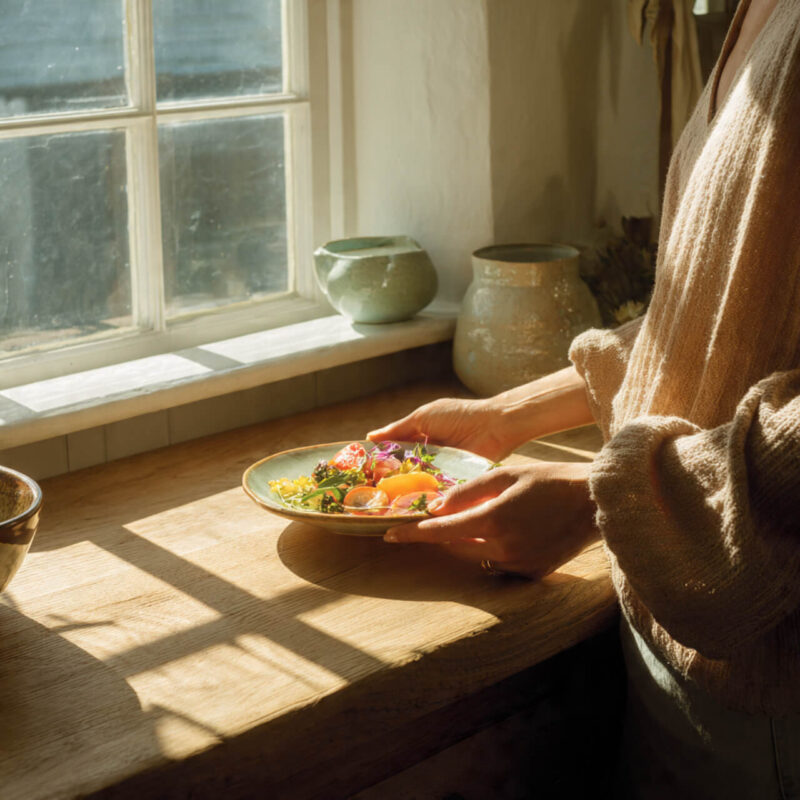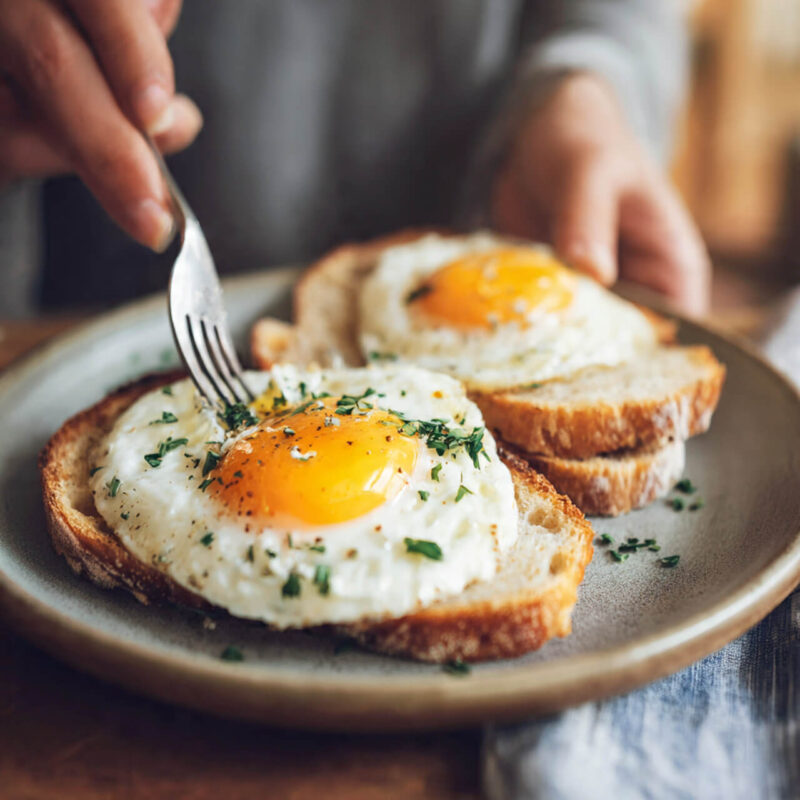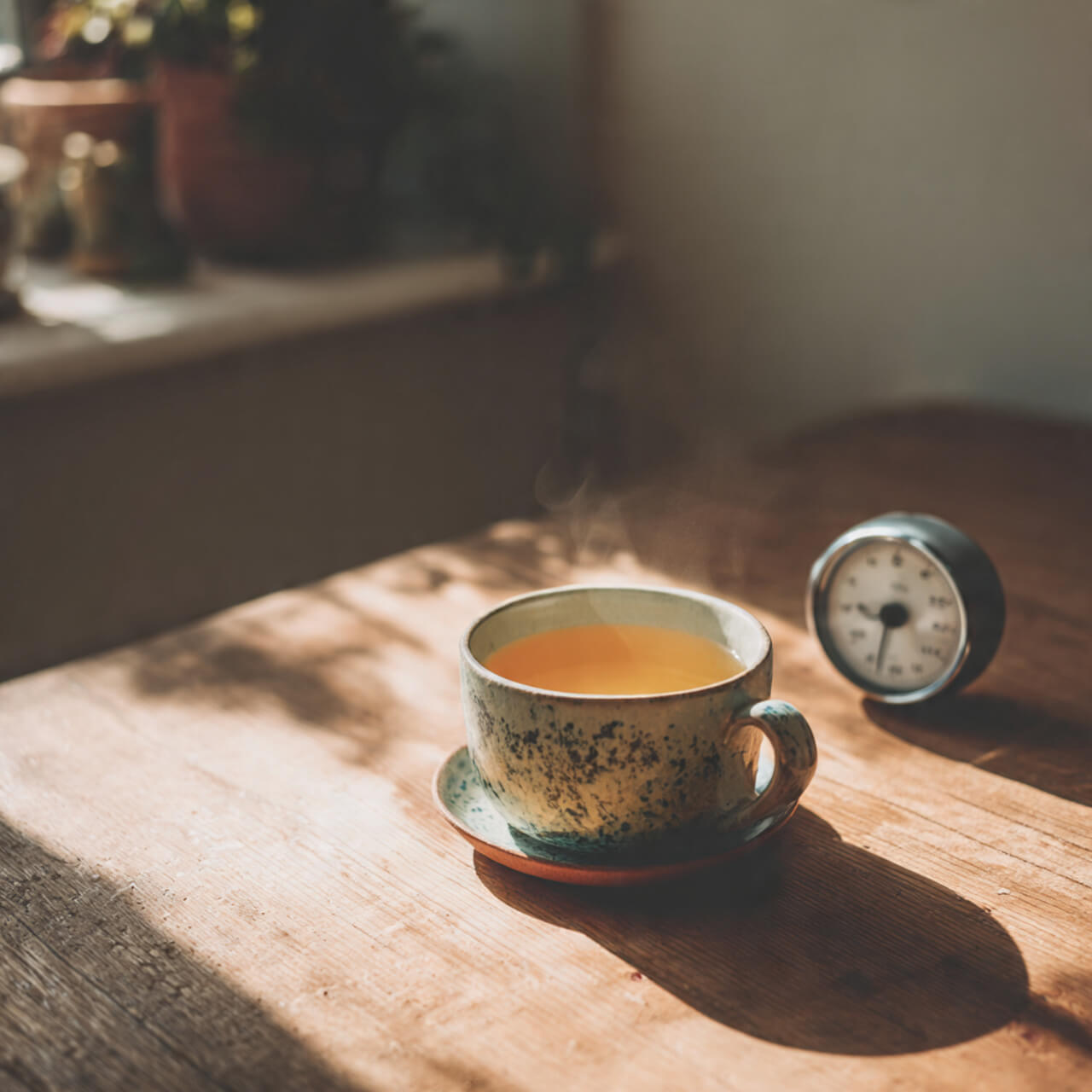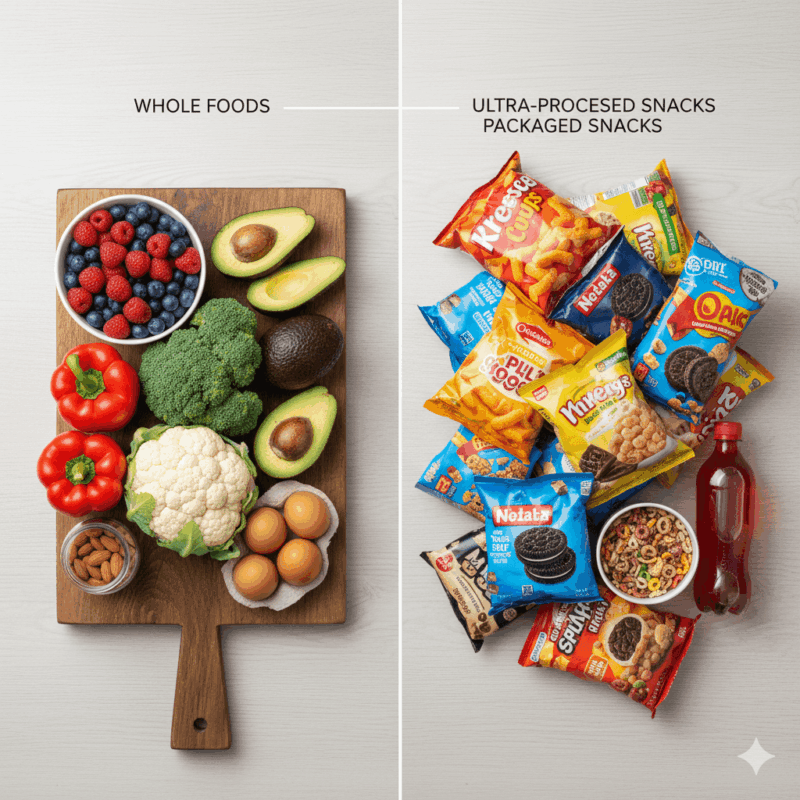Read time: 17 minutes
Quick Summary:
These five small daily habits create automatic weight loss without willpower by redesigning your environment and not relying on willpower. No tracking, no restriction, just setup once and let your biology do the rest.
How to Lose Weight Without Willpower Using Environmental Design
It’s 9 PM. You’re standing in front of the pantry, hand hovering over something you said you wouldn’t eat today.
Again.
You know what happens next. You’ll eat it. Then you’ll feel that familiar sinking feeling—not guilt exactly, more like resignation. Like watching yourself make the same choice you’ve made a hundred times before, completely unable to stop.
Here’s what you’re probably thinking: What’s wrong with me? Why can’t I just have self-control like everyone else?
Nothing is wrong with you.
Research from the University of Toronto shows that willpower depletes throughout the day like a phone battery (University of Toronto research on willpower depletion). Every decision you make drains it slightly. By 9 PM, after 200+ food decisions (Cornell University’s estimate), you’re running on 2%.
Why Willpower Was Never the Problem
That’s not a character flaw. That’s biology.
“Most people don’t fail diets because they lack discipline. They fail because their environment is designed for overeating.”
— Dr. Brian Wansink, Cornell Food and Brand Lab
This is why 95% of people regain lost weight within five years, according to the American Journal of Clinical Nutrition. They’re fighting human nature with the wrong tools.
The solution? Stop fighting. These five habits will help weight loss without willpower through environmental design, not discipline.
No willpower required and no forbidden foods. Just small changes that make healthy eating your default, not your battle.

Disclaimer
I’m a coach, not a clinician. What I share comes from real practice and lived experience, not medical advice. If you’re struggling with your weight or mood, please reach out to your GP or a qualified nutrition professional — support makes a difference.
Contents
- Key Takeaways
- Why Do You Keep "Failing" Weight Loss Plans?
- Why These Habits Work for Weight Loss Without Willpower
- Eat Protein First to Control Hunger Naturally (Habit 1)
- Use Smaller Plates to Manage Portions Automatically (Habit 2)
- The 20-Minute Pause That Stops Overeating (Habit 3)
- How Sleep Quality Affects Weight Loss (And How to Fix It) Habit 4
- Simple Food Swaps for Weight Loss Without Deprivation (HABIT 5)
- How These Environment-Based Weight Loss Habits Stack
- Your First 30 Days of Weight Loss Without Willpower
- 3 Actions You Can Take Today
- Everyday Mastery Steps You Can Take Now
- Your Choice Right Now
Key Takeaways
- Willpower depletes throughout the day and these habits help eliminate the need for it
- Small environmental changes create effortless weight loss without willpower habits without restriction
- Implementation: Start with one habit for 7 days, then add another
- Expected results: Improved digestion, steadier mood, and more awareness of what actually satisfies you. Weight change varies person to person — the real win is building a foundation for it to happen naturally over time.
- No foods are forbidden—just strategic environmental design that works with your psychology
Why Do You Keep “Failing” Weight Loss Plans?
Spoiler: You’re not failing. The approach is failing you.
Willpower is finite.
Stanford psychologist Kelly McGonigal’s research proves that self-control depletes with use. Make 200+ food decisions daily, and you’re guaranteed to crack eventually.
Biology fights restriction.
When you dramatically cut calories, your body doesn’t know you’re trying to lose weight—it thinks you’re starving. Your metabolism slows. Hunger hormones spike. Your brain amplifies cravings to survival levels.
You’re not weak for wanting that cookie. Your brain has literally turned up the volume to maximum.
If that sounds familiar, you might enjoy this related post on how to overcome perfectionism — because chasing perfect plans is often what keeps people stuck.
The restriction mindset backfires.
The moment you tell yourself you can’t have something, that food becomes all you think about. One “forbidden” food becomes a “ruined day” becomes giving up entirely.
Here’s the uncomfortable truth: You’ve been trying to find the “right” eating plan when what you actually need is a pattern that fits your life.
Not someone else’s rules.
Not deprivation.
Just sustainable weight loss without willpower that works even when you’re exhausted.
Why These Habits Work for Weight Loss Without Willpower
If you’re sceptical right now that’s good. You’ve been burned before.
But here’s what’s different: previous habits probably still required daily willpower. These don’t. You set them up once, then they run on autopilot.
You’re not relying on motivation. You’re relying on physics and environmental design.
This is the same mindset behind habit stacking — linking one small action to another until consistency becomes automatic.
The funny thing is, once you stop trying to rely on discipline, real change feels easier than you expect. That’s where these first habits come in, small shifts that work quietly in the background.
Let’s go.

Eat Protein First to Control Hunger Naturally (Habit 1)
The Science
Protein triggers satiety hormones (peptide YY and GLP-1) that signal fullness to your brain. Dr. Mike explains this in detail here. University of Washington research found that increasing protein to 30% of calories led to a spontaneous reduction of 441 calories per day, without conscious restriction.
Ever been to a restaurant and noticed how they offer bread first? That’s not an accident. When you start with carbs before protein, your blood sugar spikes and you often end up eating far more than you intended. The bread basket isn’t just hospitality what it is its strategy.
The Habit
Before eating anything else, take your first 3-5 bites of protein. Eggs, chicken, Greek yogurt, tofu, beans or whatever you’re having.
Why This Requires Zero Self-Control
You’re not eliminating carbs. You’re just changing the order.
By the time you reach the pasta, your satiety hormones are already working. You naturally want less without feeling deprived.
This isn’t restriction. It’s just eating the same foods in a different sequence.
Set It Up Once, Benefit Forever
- Put protein front and center on your plate
- At restaurants, eat protein before touching sides
- For breakfast, eat eggs before toast
- Meal prep: portion protein first
Use Smaller Plates to Manage Portions Automatically (Habit 2)
The Science
Cornell’s Food and Brand Lab found people consume 20-30% more food when using larger plates (Cornell Food and Brand Lab’s portion-size research). Your brain judges portions visually, not by actual volume.
A full 9-inch plate signals “complete meal.”
The same amount on a 12-inch plate looks pathetic.
For liquids, tall narrow glasses make volumes appear larger than short wide glasses—so you naturally drink more water.
The Habit
Serve all meals on 9-inch plates (salad plate size). Drink water from tall, narrow glasses (12-16 oz).
Why This Requires Zero Self-Control
You’re not consciously eating less—you’re using visual psychology. Your brain sees a full plate and feels satisfied.
Just automatic, appropriate portions of whatever you want.
Set It Up Once, Benefit Forever
- Tonight: Move 9-inch plates to eye level in your cabinet
- Put large plates on a high shelf
- Buy one tall water glass you actually like
- At restaurants, ask for a to-go box before you start eating
The funny thing is, these shifts start to overlap fast. One small change quietly makes the next one easier. If you’ve ever wondered why it’s hard to stop after a big dinner, the next habit shows you why waiting a little longer can completely change how much you eat.

The 20-Minute Pause That Stops Overeating (Habit 3)
The Science
Fullness signals take 15-20 minutes to reach your brain. University of Rhode Island research shows fast eaters consume 70+ more calories per meal—not because they’re hungrier, but because they eat past fullness before the signal arrives.
The Habit
When you want seconds or reach for a snack, set a 20-minute timer. Do something else. When it goes off, reassess: still hungry?
Why This Requires Zero Self-Control
You’re not saying “no.” You’re saying “not yet.”
That tiny distinction removes all psychological resistance.
Most of the time, after 20 minutes, you’ll realize you don’t actually want more food. Your body just needed time to catch up.
Still hungry after 20 minutes? Eat. No guilt.
Set It Up Once, Benefit Forever
- Create a preset timer on your phone: “Still hungry?”
- Leave the kitchen after meals—go to a different room
- At restaurants, take a restroom break before ordering dessert
If digestion or gut comfort is something you’re working on too, this gut health habit guide shows how small daily changes can transform your energy and focus from the inside out.
The Unexpected Truth
Here’s what nobody tells you: most of what you think is hunger is actually just the absence of fullness signals.
Once those signals arrive, the craving disappears.
You’re not fighting hunger. You’re just waiting for your body to tell you the truth.
So if your hunger still feels unpredictable, it’s not just about food — it’s about recovery. Your body can’t regulate cravings when it’s running on empty, which is why sleep becomes the secret weight-loss habit nobody talks about.

Enjoying this so far? Get calm, practical habit tips like this every week — join the Everyday Mastery newsletter.
How Sleep Quality Affects Weight Loss (And How to Fix It) Habit 4
The Science
University of Chicago research found that sleep-deprived people:
- Produce 18% more ghrelin (hunger hormone)
- Produce 15% less leptin (fullness hormone)
- Crave high-calorie foods 33% more
- Have decreased impulse control
Sleeping at 65-68°F activates brown fat (which burns calories) and improves deep sleep quality. Darkness boosts melatonin production, which influences metabolism and insulin sensitivity according to research published in Diabetes Care (University of Chicago sleep and appetite study).
The Habit
Set your bedroom to 65-68°F at night. Eliminate all light—blackout curtains or sleep mask, tape over LEDs, no phone screens 30 minutes before bed.
Why This Requires Zero Self-Control
When you’re well-rested, hunger hormones normalize.
You don’t need willpower to resist the cookie—you genuinely don’t want it as much. Your brain’s decision-making regions function properly. Cravings quiet down naturally.
Poor sleep makes every habit harder.
Good sleep makes them all easier.
For more energy tips, you can read 7 simple food swaps for when you’re tired all the time.
Set It Up Once, Benefit Forever
- Program your thermostat to drop temperature at 9 PM
- Install blackout curtains or use a sleep mask
- Tape over LED lights
- Charge your phone outside the bedroom
- Set a “wind-down” alarm 30 minutes before bed
The Real Kicker
You’re not tired from eating badly. You’re eating badly because you’re tired.
Fix sleep first. Everything else gets easier.
The best part? Each small change supports the next. You’re not juggling five rules you’re building a calm, automatic system that makes healthy choices happen naturally.

Simple Food Swaps for Weight Loss Without Deprivation (HABIT 5)
The Science
Ultra-processed foods are engineered to override your fullness signals. Food scientists design the perfect “bliss point” that hijacks your brain’s reward system.
Whole foods contain fiber and water that trigger natural satiety. Penn State research found people naturally ate fewer calories with whole foods—without being told to restrict (Penn State research on whole foods and satiety).
You can go deeper into this idea in Ultra-Processed Foods: Simple Changes That Actually Work.
The Habit
Each week, replace ONE processed food with its whole-food version. These simple food swaps for weight loss don’t require cooking skills or extra time—just different choices at the grocery store.
Try one each week;
- Flavoured yogurt → Plain Greek yogurt + fresh berries
- Crisps → Air-popped popcorn with your own seasonings
- Store-bought dressing → Olive oil + vinegar + herbs
- Sugary cereal → Oatmeal with banana and cinnamon
- Frozen pizza → Homemade with whole wheat pita + real toppings
Why This Requires Zero Self-Control
You’re not eliminating anything or creating “forbidden foods.” You’re swapping one thing at a time.
Your palate gradually adapts. After a few weeks, the ultra-processed version tastes too sweet or artificial.
By month six, you’ve transformed your eating pattern without a single moment of restriction.
Set It Up Once, Benefit Forever
- Stop buying the processed version (if it’s not there, you can’t eat it)
- Prep the swap in advance so it’s just as convenient
- Start with something you’re neutral about, not your favorite comfort food
The Identity Shift
You’re not “trying to eat healthy.”
You’re becoming someone who eats mostly whole foods because that’s what tastes good now.
That identity is sustainable. Temporary plans aren’t.
How These Environment-Based Weight Loss Habits Stack
Better sleep normalizes hunger hormones → easier to eat protein first
Protein first triggers faster satiety → smaller portions feel satisfying
Smaller plates mean less volume → fullness signals arrive faster
Whole food swaps reduce manufactured cravings → everything requires less effort
You’re not managing five separate behaviors.
You’re creating an ecosystem where each element makes the others easier.
If you want to see how stacking these small habits works in other parts of life, try the Habit Stacking guide.
And If you’re ready to turn those small lifestyle tweaks into real physical movement, here’s a gentle guide on how to start exercising when overweight without shame or pressure.
Your First 30 Days of Weight Loss Without Willpower
Don’t try all five at once. That’s old thinking.
Week 1: Pick One Habit
Choose the habit that feels easiest. For most people, it’s smaller plates—zero skill, works immediately.
Week 2: Add a Second Habit
Once the first habit feels automatic, add another. Most people choose protein-first or the 20-minute rule next.
Week 3-4: Layer In the Rest
By now you have momentum. Add the remaining habits one at a time.
The Rule of Imperfection
You will forget and you’ll use a big plate. You’ll eat past fullness. You’ll have a week where you do none of this.
That means nothing about you.
These habits work even at 60% compliance. There’s no wagon to fall off. Just tools you use more often than not.
Progress, not perfection.
3 Actions You Can Take Today
- Move your smaller plates to eye level tonight. It instantly changes how much you serve without any tracking or effort.
- Eat your protein first at breakfast tomorrow. Just three bites before anything else — it’s that simple.
- Set a “Still Hungry?” timer for 20 minutes. Let your body tell you when it’s actually full.
Everyday Mastery Steps You Can Take Now
- Notice when you’re using willpower instead of structure. That’s your cue to redesign, not push harder.
- Try one swap this week, not five. Change that feels too easy is change that lasts.
- Remind yourself: “I’m not failing, I’m learning what works for me.” That’s mastery in motion.

Mr Critic Moment:
“Five habits? Sounds like another self-help checklist you’ll abandon by Wednesday.”
But here’s the thing — this isn’t about being perfect or sticking to rules. It’s about making your environment so kind and automatic that even your inner critic runs out of things to say.
Or maybe your “inner critic” isn’t a voice at all — it’s that quiet resistance that makes the sofa look extra comfortable. Different form, same message: “Are you sure you can do this?”

Journaling Prompt:
Which of these five habits feels easiest to start this week?
What tiny change would make it even easier to keep going when i’m tired?
For additional science-backed tips, check out the NHS guide to healthy eating.
Your Choice Right Now
You have two options.
Option 1: Close this tab and tell yourself you’ll start Monday. Watch Monday come and go like it always does then keep standing in front of that pantry at 9 PM wondering what’s wrong with you.
Option 2: Go to your kitchen right now. Move your small plates to eye level. Put the large plates on the top shelf. That’s it. Five minutes. One habit set up.
Tomorrow morning, eat protein first. Three bites before anything else.
That’s all transformation asks not for motivation, just setup.
Six months from now, you’ll look back and see what’s changed you will see the real weight loss without willpower, just small systems that worked quietly in your favour.
You’re not
If you enjoyed this post, you can get new ones like it straight to your inbox.
👉 Join the Everyday Mastery newsletter — simple habits, real stories, and calm progress, every week.
If you’d like to support the writing, you can buy me a coffee — it keeps the kettle (and the ideas) warm.
Kel is the writer behind Everyday Mastery, where she shares the real, messy, and meaningful process of building habits, resilience, and self-belief from the ground up. Her writing blends ancient philosophy with modern science, always focused on small, practical steps that lead to lasting





